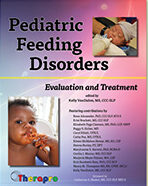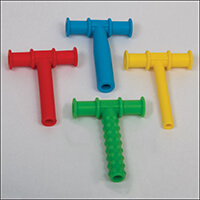On Tuesday night, Therapro was pleased to host a highly attended webinar presented by Dr. Kate Barlow, focusing on Oral Motor Treatment and Feeding strategies. This blog is part of a multi-post series that explores key points from Dr. Barlow’s webinar. In this entry, we specifically highlight treatment strategies related to feeding.
Dr. Barlow is an Assistant Professor at American International College. She is also the current ambassador for the CDC’s Learn the Signs Act Early program for the state of Massachusetts. She has over 20 years of clinical experience, including public school practice, early intervention, and a pediatric hospital-based outpatient clinic, as well as management. Dr. Barlow’s passion is in global outreach; she founded the International Interprofessional Mentorship Program that currently provides mentorship to over 100 therapists in developing countries in Africa and South America.
Dr. Barlow’s extensive knowledge in this area was evident as she seamlessly broke down this complex topic into manageable bits of information. Dr. Barlow set out with the main objectives of providing viewers with specific intervention strategies for oral motor deficits and relaying the importance of screening all children for feeding difficulties. As one viewer stated:
“This was one of the best courses I’ve taken in a long time. The instructor was knowledgeable with practical assessment and treatment strategies that I can even use in collaboration with SLPs. So many OTs are intimidated to address feeding, especially in the school setting, but I think it is so important!” -LB
Viewers left with some great take-aways that we will recap in this post:
1. Guidelines for making food recommendations.
2. The importance of enjoying food.
3. All children should be screened for feeding disorders.
Guidelines for Making Food Recommendations. Match food choice with skill level. When Dr. Barlow discussed guidelines for recommending appropriate food choices, she stated simply “look at the child in front of you and where they are developmentally.” This bit of advice was a great reminder for new and experienced therapists alike; a child’s skill level isn’t necessarily defined by their age. Dr. Barlow highlighted this further by showing that the development of circular rotary chew could occur on a widely varied timeline, anywhere between 18 to 36 months!
The Importance of Enjoying Food. Another important takeaway from Dr. Barlow’s webinar was the importance of enjoying food. She spoke passionately about the importance of understanding underlying medical problems when addressing feeding difficulties. Dr. Barlow explained that behavioral problems around eating can often be addressed when the feeding difficulty is appropriately treated. Another point she raised is the importance of a child being included at the family table. She stressed the importance of this inclusion, in whatever capacity the child is capable (even if it meant that they were just sucking on a lollipop), because the mealtime experience is an important cultural ritual.
All Children Should Be Screened for Feeding Disorders. A third take away from Dr. Barlow’s webinar was the importance of screening all children for feeding difficulties regardless of why that child is on your caseload. She highlighted the prevalence of feeding difficulties as a key factor in this; I was struck by how prevalent feeding difficulties are even in typically developing children. Dr. Barlow cited research indicating feeding difficulties are present in one in four typically developing children. In children with developmental disabilities and cerebral palsy, the prevalence is significantly greater. With this information, I found myself reflecting on all that I knew about the role of nutrition in supporting optimal behavior for participation. The concept of screening all children for feeding difficulties truly makes sense when considering the prevalence of feeding difficulties and the role that nutrition plays in a child’s ability to attend and participate in all of their daily activities.

A great resource for information on oral motor and feeding treatment is a book published by Therapro: Pediatric Feeding Disorders Evaluation and Treatment. It covers topics ranging from the progression of feeding development, to the role of the gastrointestinal system in feeding difficulties, to the evaluation of feeding difficulties, along with a broad range of other feeding topics! Stay tuned for future blog posts where we continue our review of Dr. Barlow’s webinar, exploring her tips and suggestions for screening pediatric feeding difficulties as well as some of her great treatment strategies!

